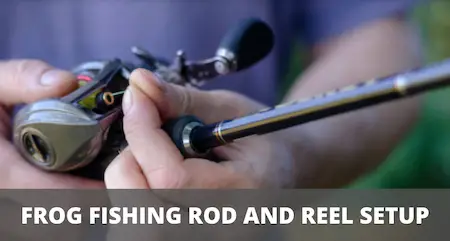Best Topwater Frog Setup (Explained)
UPDATED 03 NOVEMBER 2023
by Robert Ceran
Frog fishing is one of the most enjoyable ways to catch bass in the summer, as there is nothing quite like seeing a bass blow up on your lure, and then feel it bend your rod as it dives for cover after you set the hook.
But in order to be successful with this tactic, it’s really important to have the right gear, since it’s easy to end up losing a lot of good fish if you don’t.

So what is the best setup for topwater frog fishing?
Here’s the quick answer
- Rod: 7’3” heavy power fast action baitcasting rod
- Reel: 8.0:1 gear ratio high speed baitcasting reel
- Line: 65 lb test braided line
Now let’s dive into the details, to get the full picture.
Best rod setup for frog fishing
A good frog rod is the most important part of your frog setup.
This is because frog lures come with two large hooks, and it takes a lot of force to drive the points of the hooks home into the hard mouth of a bass.
This is especially true if you’re making long casts, and you get a bite 30 or 40 feet away from you. So you’ll need sufficient backbone to set that hook at a distance.
In addition, frogs are most often thrown in or around heavy cover, and if you hook a large fish in these kinds of settings, you’ll need plenty of power to force that fish away from all opportunities of entanglement.
That’s why lightweight finesse rods really have no place in frog fishing.
What type of rod should you use for frog fishing?
The best type of rod for frog fishing is a baitcasting rod. Baitcasting poles have significantly higher casting accuracy compared to spinning poles, and this is extremely useful if you are trying to place your lure in a very specific spot near to cover. This could be a log in the water, a lily pad, or any other kind of structure that attracts bass. But the key here is that you need extremely high casting accuracy to hit those spots.
In addition to accuracy, casting poles also have greater casting distance, which gives you another big advantage if you’re throwing your lure in big shallow lakes that have large grass flats or extensve fields of lily pads.
What action rod is best for frog fishing?
The best action for frog rods is fast action. A fast action rod has a soft tip with a stiff backbone, and you need that soft tip for walking and popping your frog on the water surface. When you get really good at this technique, you can twitch your lure back and forth in one spot, without actually retrieving it, which is great for staying inside the strike zone as long as possible.
But while you do need that soft tip for the best lure action, you also want the rest of the pole to be as stiff as possible, since you need to set those big hooks in a hard bass mouth (and sometimes at a great distance). That’s why you shouldn’t choose a moderate action rod, since rods with this action bend all the way down to the middle.
What rod power is best for frog fishing?
The best power for frog rods is heavy power, since you need a very strong backbone to set those big hooks, and to keep big fish pinned down before they manage to dive into the cover they came out of to grab your lure. Also, if the fish does get entangled, a heavy power rod can help you to extract it together with a whole bunch of plants wrapped around it. It’s quite common to land a 4 or 5 pound bass together with 10 pounds of weeds.
Best frog rod length
The best length for frog rods is 7’1” to 7’5”. It’s necessary to have a rod that’s longer than average, since that gives you more leverage when you need to set that hook at 30 or 40 feet distance, and it also comes in handy for forcing a big bass away from cover as fast as possible. Also, a longer pole can cast further, which is helpful if you’re casting in big grass flats. Depending on your height, you may want to choose a slightly shorter or longer length.
Best reel setup for frog fishing
The right choice of reel is also critical for your frog fishing setup. As mentioned above, you need lots of power for this tactic, and that’s where baitcasting reels really excel, since they perform very well with thick, heavy braided lines, and can cast big lures without problems. This is exactly what you need for this type of fishing, where you’re usually throwing 1/2 oz lures on 50 or 65 lb test braid.
When you choose your baitcasting reel, make sure you get one that’s made predominantly of aluminum parts. Ideally it should have an aluminum frame and aluminum side plates. This is because this method requires setting the hook with extreme force to drive home the big hooks, and graphite reels can get warped by this pressure, while aluminum doesn’t.
Can you fish a frog on a spinning reel?
Yes you can fish a frog with a spinning reel setup, but keep in mind that this doesn’t give you the same degree of power that a baitcasting rod and reel setup would. And you’ll really need a frog fishing setup with sufficient power to haul big bass out of heavy cover. Spinning reels are best used for finesse applications, which just doesn’t apply when you’re throwing frogs.
What gear ratio is best for frog fishing?
The best gear ratio for frog fishing is 7.5:1 to 8.0:1. It’s important to get a reel with a high speed retrieve rate, since you need to pick up your slack as fast as possible when a bass grabs your lure, so you can set the hook. A high speed reel will help you to do this fast enough to set the hook effectively.
A high speed reel also allows you to burn your lure back to the boat so you can make another cast as fast as possible. This is very helpful when you get a short strike 30 or 40 feet away from the boat, and want to throw your lure back into the same spot right away, to target that same fish.
What line should you use for frog fishing?
Braided line is the best choice for frog fishing. The main reason for this is that it floats on the water, and this is exactly what you need for this topwater fishing tactic. Also, braid doesn’t have any stretch, which is extremely helpful for setting the hook when a bass grabs your lure a long distance away from the boat, or you need to haul it away from lily pads or other cover.
If you’re fishing in very clear water, and think that braid might be too visible for the fish, you can also tie a monofilament leader to your braid main line. But this is very rarely necessary – most anglers just tie the braid directly to the frog, and catch plenty of fish that way.
What size line is best for frog fishing?
The best size line for frog fishing is a 65 lb test braided line, which is ideal when you’re fishing in heavy cover. On the other hand, if you’re fishing in fairly open water with sparse cover, a 50 lb test braid is strong enough, and this also has better casting properties than the 65 lb test.
Always keep in mind that this tactic was designed for fishing in locations with lots of vegetation, and when you hook a big bass in these settings, it will always try to dive into the thickest part of that growth. So that means your setup must be strong enough to bring in that fish with an additional 10 or 20 pounds of plant material wrapped around it.
